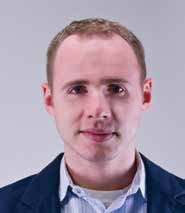CRESTRON’S DAN JACKSON HELPS DESIGN THE FUTURE OF AV CONTROL

Quick Bio
Name: Dan Jackson
Title: Marketing and Development Engineer
Company: Crestron
It might now seem inevitable that Dan Jackson would end up working at Crestron, but that wasn’t the plan—initially, anyway. “I think my high school yearbook quote was something to the effect of, I’m going to go and live in California and drive a convertible,” said Jackson, who, at 32 years of age, is senior research and development engineer at Crestron Electronics in New Jersey, where he grew up.
But while Jackson was “intentionally going in a different direction,” he said, he did end up interning with his mother, a senior software engineer—now director of software tools and quality engineering—at Crestron, while he was studying computer engineering and economics at Northwestern University. What put him onto his present career path, however, was when he went to work for Elexos, a Crestron-authorized independent programmer based in Chicago. Working in the field on high-end residential automation systems throughout the Midwest, he soon figured out where the technology could be improved.
“I had a lot of insight into how systems had to be designed,” said Jackson, who subsequently joined Crestron in 2006 as the first member of the R&D department, which he also managed as it expanded. Crestron had about 200 engineers at the time, he recalled, but the R&D department was “specifically set up to investigate technology and the markets and, separate from engineering, drive the shifts in what we should be doing.”
The first line of inquiry was, “what’s the next generation of video distribution?” he said. “The way we figured it out was by asking the question, ‘where does content come from?’”
Crestron was using PVID on its residential products and had QuickMedia for the corporate market, he recalled, but they were incompatible and didn’t offer a way forward. “One of the big technology shifts that was happening was HDMI and HDCP, which were going to drastically affect how integrators went about their business,” he said. “You have to put encryption on content throughout your entire system. You basically have to throw out everything you’ve done and start from scratch.”

Dan Jackson stops to take a photo during a recent family outing That was the genesis of Crestron’s central platform, DigitalMedia.
Yet as the design came together, it became obvious that current technology couldn’t support Jackson’s dreams for the product. To support streaming, which is what Jackson wanted, would have required incorporating a full-blown computer, so the team instead implemented HDBaseT and HDMI solutions.
“It was a different world—and it wasn’t that long ago,” he laughed. “We stepped back and said, ‘what’s happening now and what’s going to happen 10 years from now?’ Luckily we were right. It could do everything that we could do at the time, but we also had all the hooks and infrastructure in there to do streaming as it came down the road.”
Along the way, he developed technologies—some that he patented—to manage HDCP content, including the ability to separate audio from video in order to retain some of the familiar analog workflows, and to handle EDID and CEC data. While DigitalMedia initially transmitted AV signals over Cat-5e, Jackson also worked to integrate single-mode and multimode fiber transports into the platform.
Jackson, who was the recipient of the 2014 CEDIA Electronic Lifestyles Young Professional of the Year award, has also worked on Crestron’s AirMedia, which enables wireless presentation and collaboration between up to 32 meeting participants, and CAPTURE-HD, a 1080p solution for recording events such as lectures, presentations, and training sessions.
Jackson has also continued to be involved with the development of Crestron’s streaming solutions. Looking forward to the next 10 years, he said, “I think a lot of it is going to be about software and streaming; I don’t think anybody would dispute that. Ethernet is operating in an industry that is orders of magnitude larger than ours, and ethernet essentially takes over everything else once it becomes quick enough to replace it.”
But there is another reality regarding content: “Some content is moving away from the standard that we use to move video around, HDMI, and you have to access it in other ways. The next generation of video distribution is going to be about making sure you have access to the content in all the right places, mobile and network-based as well as HDMI.”
A new product incorporating Microsoft Lync 2013 has Jackson excited about taking Crestron into a new market segment: unified communications. “I think products around that space are going to be hugely important. It’s not just videoconferencing; it’s being able to communicate from anywhere in any way you want,” he said.
“It’s about bringing this technology everywhere. If your technology isn’t working, your building’s not working.”
